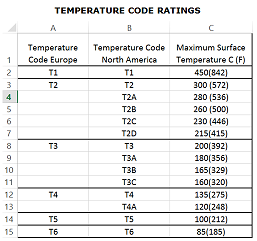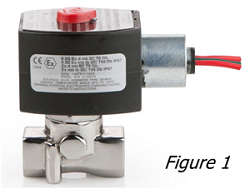European vs. U.S. Temperature Code Ratings for Solenoid Valves
Solenoid valves are vital components of many process automation systems.
#components #automation
The Advantages of Global Approvals
As more companies conduct their operations on a global scale, products that have received global ratings and approvals by appropriate standards bodies naturally become more popular.
For solenoid valve purchasers, global approvals offer multiple advantages:
- Due to rationalization of parts, a single design/setup can be used in multiple regions. This simplifies end-users’ supply chains.
- Users can specify one valve, track one SKU number and be assured of consistent quality.
- Companies with operations in multiple locations can simplify ordering and stocking of their spare parts and rebuild kits.
- Users can streamline training, operation—and especially maintenance.
- All the above can help to cut costs and reduce inventory efforts.
From the users’ point of view, the ideal approvals regimen would feature one global set of standards emanating from one agency—or at least one set of common standards across multiple agencies.
This ideal may be attained someday, but not soon. For the foreseeable future, users will be required to deal with multiple agencies issuing multiple ratings and approvals. Valve suppliers that obtain multiple approvals for the same valve greatly aid their users in their global stocking efforts. However, companies specifying and using these valves must deal with multiple temperature codes (Tcodes) on each product. Users must interpret these ratings correctly to make the right specifying decisions.
The Approvals World
For solenoid valve purchasers around the globe, key approval agencies with international profiles are UL in the United States, CSA in Canada, and ATEX and IECEx in Europe. Local agencies—such as NEPSI or INMETRO—typically accept test reports from these four major agencies and use the same standards, often under official crosscertification agreements.
Fortunately, local approvals almost invariably follow either U.S. or European methods. For this reason, knowledge of temperature ratings and approvals systems accepted in the U.S. and Europe will serve users well in making almost any valve specifying/purchasing decision.
- ANZEx - Australian Program for the Certification of Equipment for Explosive Atmospheres INMETRO - National Institute of Metrology, Quality and Technology
- CSA - Canadian Standards Association
- NEPSI - National Supervision and Inspection Center for Explosion Protection and Safety of Instrumentation
- ATEX - (Devices for Use in) Explosive Atmospheres
- IECEx - International Electrotechnical Commission System for Certification to Standards Relating to Equipment for Use in Explosive Atmospheres
- KOSHA - The Korea Occupational Safety and Health Agency
- CUTR - Customs Union Technical Regulations
- TIIS – Japanese Test/Certification body
- SANS - South African National Standards
- UL - Underwriters Laboratories Inc.
- FM - Factory Mutual
Approvals from U.S. agencies
In the U.S., approval types are based on area classification. These vary depending on the type of hazardous environment in which a given device can be used.
U.S. systems focus on two basic explosionproof area classifications:
- Class I, Division 1: where flammable gases, vapors, or liquids can exist under normal operating conditions
- Class I, Division 2: areas adjacent to Class I, Division 1 locations, where flammable gases, vapors, or liquids can be present occasionally
Approvals from European Agencies
In contrast to U.S. area classifications, European systems group their approval types based on zones. Zone 0 and 1 are similar to the U.S. Class I, Division 1 certification, while Zone 2 is similar to Class I, Division 2. Each zone has a different method of protection for a given device—flameproof enclosure, encapsulate, etc.
Users may encounter four popular types of protection methods for valve products. These methods are designated by the protection methods d, m, e and i:
- “d” — A component that can ignite an environment containing explosive gas is placed in a metallic enclosure. If the component causes ignition of the explosive gas inside the box, the enclosure will be strong enough to contain the explosion without letting it propagate to the outside environment. This method is considered to offer the best protection in an explosionproof environment.
- “m” — A component that can cause ignition (via arcing or sparking) is encapsulated by a compound that prevents the explosive environment from being ignited. Thus potentially explosive gases and component arcing/sparking sources are isolated from one another.
- “e” — Spacing between electrical parts is strictly controlled, so that a component cannot produce arcs or sparks that might cause ignition in an explosive environment.
- “i” — Power levels of electrical components are so low that, even under fault conditions, there is not enough energy to produce ignition. An intrinsically safe barrier is required, but a full enclosure is not needed. This is also known as the “intrinsically safe” method.
Users should develop a basic understanding of these codes to apply them correctly in specifying and/or purchasing solenoid valves.
Tcodes: Defined
A “Tcode,” or temperature code, states the maximum surface temperature that a component can reach in given conditions. (For the U.S., these are abnormal operating conditions and nominal voltage. For Europe, they are normal operating conditions and 10% over nominal voltage.)
Basically, a valve’s Tcode offers temperature information that’s critical to the safe operation of that valve.
The process industries (including oil and gas, chemicals, power generation and others) possess many hazardous locations where an explosion could cause extreme damage, as well as personal injury or loss of life. For example, oil refineries may carry flammable gases or vapors in ambient air: a textbook case of a hazardous industrial environment. For safety in such an environment, it’s of paramount importance to determine if any component can become hot enough to ignite those gases or vapors.
The minimum temperature at which a gas or vapor will ignite is known as its autoignition temperature (AIT). All flammable chemicals have a characteristic AIT. For ratings purposes, the surface temperature of a product such as a solenoid valve must not exceed 80% of the AIT for a specific gas or vapor.
So Tcode ratings are assigned to products used in hazardous environments. Their purpose is to help users determine if a given solenoid valve or other electrical device can be applied in a given hazardous application/location—without reaching local AIT and thus causing gases or vapors present in that environment to ignite.
Tcodes Compared
Again, certain U.S. Tcodes are subdivided, with different temperatures for each. For instance, the European method has only one T2 code, at 300° C (572° F). By contrast, notice that the U.S. method lists ratings from T2 at that temperature through T2A at 280° C (536° F) down to T2D at 215° C (415° F). To avoid confusion in these or similar circumstances, some product labels state an actual temperature, instead of/in addition to a Tcode. So a label may read not just “T6,” but also “85C” or “T85” (meaning maximum surface temp of 85° C) — for greatest clarity.
In both methodologies above, ambient temperatures are significant factors in Tcode calculations. Since the European method adds that extra 5° C, some valve manufacturers label a valve with one maximum ambient temperature rating based on U.S. approvals, and another based on European approvals. Manufacturers go to the trouble of seeking these multiple approvals to keep the same Tcode and thus prevent user confusion.
Example: a product label might list a maximum ambient rating of 80° C (T5) under U.S.type approvals. However, to keep the consistent T5 rating, the same product might also bear Europeantype approvals where the maximum ambient rating might be listed as 74° C.
Tip: Check the maximum ambient temperature rating for the worst case the installation might encounter. If characteristics are otherwise similar, then select the valve according to the lower maximum ambient temperature listed on its label.
Tcodes: Beyond the Label
Example: For certain applications in some locations, the maximum ambient temperature of the facility may actually be lower than the rated maximum ambient temperature of the solenoid valve. Since U.S. Tcodes, for example, are based on temperature rise plus maximum ambient temperature, the valve would actually outperform its nominal Tcode rating. Suppose a valve or other product is rated for T4A (120° C), with a maximum ambient rating of 95° C. If in reality the facility reaches a maximum ambient temperature of only 60° C, the product might actually deserve a T6 (85° C) rating in that situation.
If conditions at the facility where the valve will be used might qualify as this kind of special circumstance, consult the valve manufacturer before specifying a final purchase.
Conclusion
At first glance, the cryptic temperature codes printed on valve labels might seem confusing. However, using the simple explanations and pointers above, the buyer or specifier can easily select the correct ratings for a given valve and its intended application and location. Matching the right solenoid valve to the right environment helps ensure safe, efficient performance. Users can also help ensure compliance and reliable performance by making sure valves are properly tested. Query a prospective supplier about the development and testing regimen a given valve has undergone: Is it extensive? Does it test all production units, or only a few? Does it subject tested units to extreme conditions? Do tested conditions match those found on the actual sites?
Manny Arceo is principal engineer at ASCO. Reach him at Manny Arceo@Emerson.com.
IECEx vs. ATEX
- Temperature code ratings and other standards from Europe may refer to either or both IECEx approvals and ATEX approvals.
- IECEx is an industry group standard. It’s the system used by the International Electrotechnical Commission (IEC) for certification to standards relating to equipment for use in explosive atmospheres.
- ATEX is a government standard. It’s derived from European Union directives that regulate what equipment and work environments are permissible in an explosive atmosphere.
- How are these two different approvals applied to evaluating electrical equipment for purchase or specification? For practical purposes, IECEx and ATEX standards can be understood as essentially identical.
RELATED CONTENT
-
The Critical Stem Nut: Who is Responsible for Maintenance?
One of the most important components of an automated threaded stem valve is the ubiquitous stem nut, a relatively simple and unsophisticated mechanical device that converts the rotary motion of an actuator into the linear stem movement needed to open or close one of the many types of gate valves or sluice gates.
-
Selecting Non-metal Materials for Valve Components and Coatings
Non-metallic materials are commonly used for valve components, and the selection of non-metallic materials for valve design and for application-specific conditions is critical to ensuring product reliability.
-
Electric Actuators in the Oil and Gas Industry
Actuators in the oil and gas industry operate many types of valves, and they must do so with great precision and accuracy.












 Unloading large gate valve.jpg;maxWidth=214)